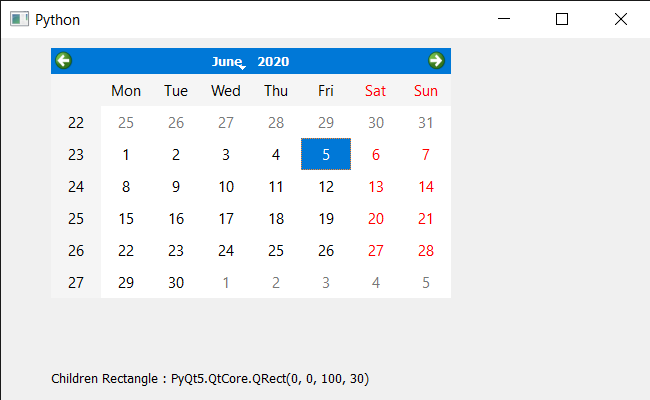En este artículo, veremos cómo obtenemos el rectángulo hijo del QCalendarWidget. El calendario no es solo un único widget, es una mezcla de muchos widgets más pequeños a los que nos referimos como elementos secundarios del calendario. Hay muchos elementos secundarios, como la vista de tabla, el delegado de elementos, etc., usamos el método de elementos secundarios para obtener todos los elementos secundarios. El rectángulo de niños es el rectángulo delimitador de todos los niños excepto los niños ocultos.
Para hacer esto, usaremos el método childrenRect con el objeto QCalendarWidget.
Sintaxis : calendar.childrenRect()
Argumento : No toma ningún argumento
Retorno : Devuelve el objeto QRect
A continuación se muestra la implementación.
Python3
# importing libraries
from PyQt5.QtWidgets import *
from PyQt5 import QtCore, QtGui
from PyQt5.QtGui import *
from PyQt5.QtCore import *
import sys
class Window(QMainWindow):
def __init__(self):
super().__init__()
# setting title
self.setWindowTitle("Python ")
# setting geometry
self.setGeometry(100, 100, 650, 400)
# calling method
self.UiComponents()
# showing all the widgets
self.show()
# method for components
def UiComponents(self):
# creating a QCalendarWidget object
self.calendar = QCalendarWidget(self)
# setting geometry to the calendar
self.calendar.setGeometry(50, 10, 400, 250)
# creating a label
label = QLabel(self)
# setting geometry
label.setGeometry(50, 280, 420, 120)
# making it multi line
label.setWordWrap(True)
# getting children rectangle
value = self.calendar.childrenRect()
# setting text to the label
label.setText("Children Rectangle : " + str(value))
# create pyqt5 app
App = QApplication(sys.argv)
# create the instance of our Window
window = Window()
# start the app
sys.exit(App.exec())
Producción :

Publicación traducida automáticamente
Artículo escrito por rakshitarora y traducido por Barcelona Geeks. The original can be accessed here. Licence: CCBY-SA